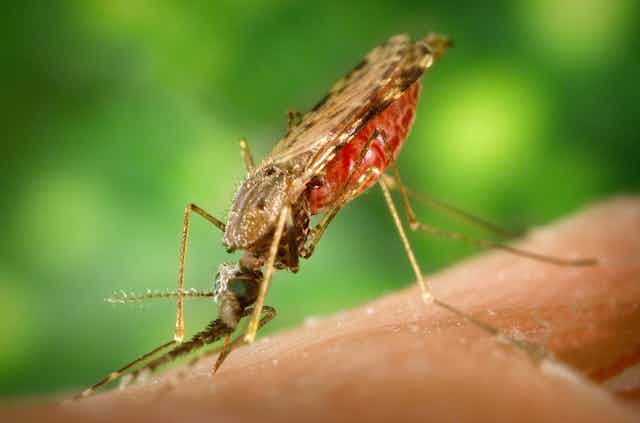Doxycycline is an antibiotic drug that kills a wide, weird and wonderful range of bugs that are often difficult to treat with other antibiotics. These include bacteria and parasites that take up residence inside our cells (called “intracellular organisms”), making them hard for most antibiotics to reach.
Unlike many other antibiotics, doxycycline penetrates deep into our tissues and ends up inside our cells, where it can kill these bugs. Examples of intracellular organisms susceptible to doxycycline include numerous “zoonotic infections” (infections that are spread from animals to humans), chlamydia, legionella (the cause of legionnaire’s disease) and malaria.
Other susceptible microorganisms include “spirochaetes” (that can cause syphilis and Lyme disease) and the bacteria that cause acne, anthrax and cholera.

Mechanism
Doxycycline interferes with a microorganism’s ability to manufacture proteins – the “building blocks” of life. Protein manufacture occurs in a part of the cell called the “ribosome” and is fundamental to any organism’s survival.
The reason doxycycline kills bacteria and parasites, but not our own cells, is that ours have a different type of ribosome to these simpler organisms.
Uses
Because doxycycline kills a wide range of bacteria that can infect the respiratory system, it is commonly prescribed for pneumonia and bronchitis. It is also widely used for treating acne and infections of the urinary and genital systems.
It is usually taken orally as tablets or capsules but can also very occasionally be given as an intravenous injection.

Doxycycline continues to exert its effects for some time after being taken. This means it can be used not only as treatment, but also for prevention or “prophylaxis”.
Its most widespread use as prophylaxis is for tourists and other travellers (such as military personnel) going to tropical countries where it is used to protect primarily against malaria. It may also provide additional protection from common bacterial causes of diarrhoea.
To be effective in preventing infection, it needs to be taken once a day during the time the person is at risk. Doxycycline is also active against a number of bacteria that could possibly be used as agents of “germ” warfare. This included, most notably, anthrax. So it could be used as prophylaxis in military or other populations thought to be at risk of bio-warfare or following release of anthrax into the environment by terrorists.
Development
The development of doxycycline followed the momentous discovery of penicillin, a natural compound produced by a certain type of mould.
This lead many pharmaceutical companies to investigate the microbe-killing properties of a large number of other natural products, such as those produced by other microorganisms and plants, a process termed “bio-discovery”.
This unearthed natural compounds with anti-microbial activity and further synthetic modification improved these natural compounds.
Resistance
Like all antibiotics, doxycycline is susceptible to bugs that develop resistance. There is evidence this has already occurred in settings where the drug is widely used, such as treatment of acne.
This means its use may be curtailed or overtaken by alternative drugs for some conditions, now or in the future.
Side effects and reactions
The most commonly reported side effect is inflammation of the oesophagus (food pipe), causing heartburn. This can be quite unpleasant but is somewhat preventable by taking the medication with plenty of water, while standing and well before going to bed.
“Photosensitivity” (heightened sensitivity to sunlight resulting in being easily sunburnt) is also common ( in up to 20% of people taking it). This is especially problematic for travellers using it as malaria prophylaxis in tropical countries.
Doxycycline should not be used in children or in pregnant women where it can result in permanent brown staining of teeth and have other effects on foetal bone development.
Doxycycline can increase the toxicity of the anti-inflammatory drug methotrexate.
Controversies
Recent high-profile controversies regarding side-effects from antimalarial drug mefloquine in defence-force personnel and refugees have highlighted the role of doxycycline as one of two main alternatives to mefloquine.
It is now generally considered a preferable initial choice to mefloquine for malaria prophylaxis. Interestingly, previous studies suggest many people actually prefer taking mefloquine to doxycycline.
This may reflect the nature of doxycycline’s side effects, but also its less convenient daily dosing (mefloquine is taken weekly).
Possible future uses
It has recently been found doxycycline affects processes in human cells, especially a group of enzymes important for the body’s inflammatory response. This property may be beneficial and could lead to applications for treating various non-infectious conditions.
These include cancers (especially those involving bone), inflammatory and autoimmune conditions (including rheumatoid arthritis and multiple sclerosis) and atherosclerotic diseases (plaque build-up in your arteries that can cause heart disease). However, these applications are currently still mostly in the experimental stage.

